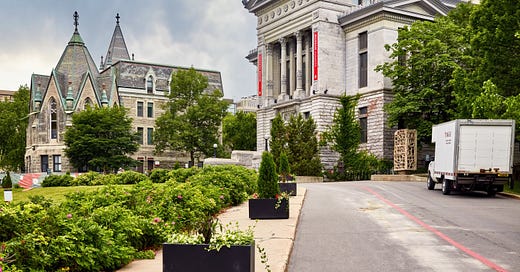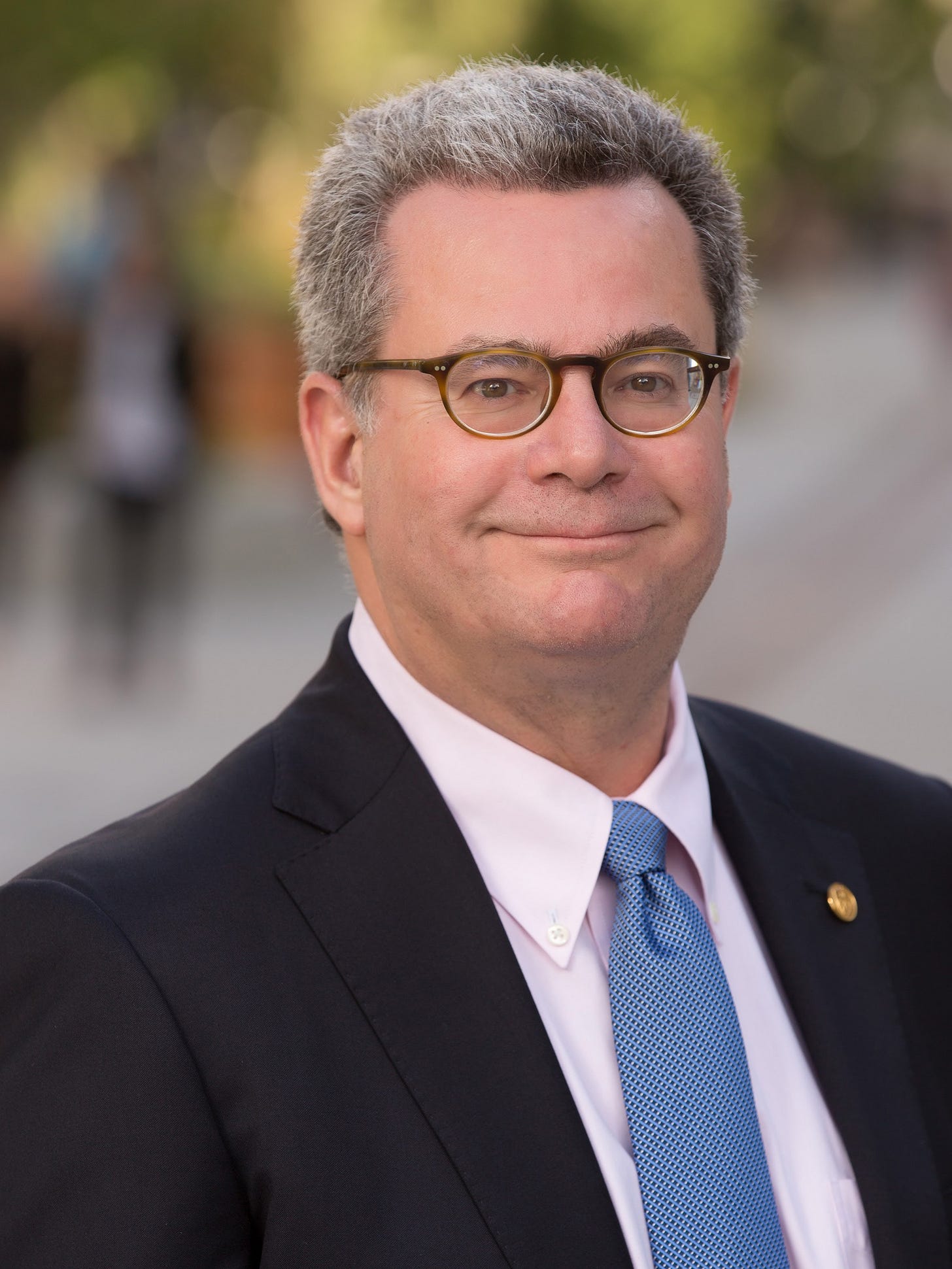If Canada wants to attract US researchers, it'll have to undo some mistakes
Guest column: McGill University's provost, Christopher Manfredi, on the opportunity too many Canadian universities can't grab
[I wrote to Christopher Manfredi, McGill University’s Provost and Executive Vice-President (Academic), after I read this editorial in the Globe and Mail urging Canada to take advantage of the Trump administration’s clumsy attempts to bring big US universities to heel. Canada “should offer… a warm refuge” to researchers whose budgets have been cut or threatened by the second Trump administration, the Globe piece argued.
I tested that argument in my panel discussion with prominent university administrators in March. McGill’s Manfredi in particular pushed back: it’s not that easy. Caps on international students introduced by both the federal government and the Quebec government have sharply limited the budgets of many leading Canadian universities. In other words, the Canadian cuts preceded the Trump cuts and have reduced Canadian universities’ ability to respond to Trump.
I asked Prof. Manfredi if he’d make that case here, in greater detail. I’m grateful to him for accepting. Here’s his column. — pw]
In 1988 I joined McGill under the auspices of something called the Canada Research Fellows program. Designed to integrate recently minted PhDs into the Canadian academy — especially those being repatriated from outside Canada, as I was — the program provided a 50% salary subsidy and a small research fund for 3 to 5 years. Think of it as a postdoctoral fellowship on steroids.
I like to think that my career, as well as the careers of excellent colleagues at McGill and elsewhere, is evidence of the effectiveness of that program. The same can be said for recent programs like the Canada Excellence Research Chairs and the Canada 150 Chairs. Together they demonstrate that Canada can react creatively to meet real needs and momentary opportunities to enhance the intellectual and research capacity of its universities, thereby benefiting Canada’s economy and society.
If announcements by prominent US-based scholars that they are leaving to join the University of Toronto are any indication, we have arrived at another moment of opportunity. Political decisions by US President Donald Trump’s administration concerning research funding and institutional autonomy have made the US a less attractive place for scholars, researchers and students, whether already at US universities or contemplating joining the US academy. Canadian universities are ready to seize this opportunity. But they can’t do it on their own.
One reason is the resilience and robustness of US universities, especially those at the upper echelon. Despite the 2008 financial crisis and the (admittedly less volatile) policies of 2016-20, they remain among the strongest universities in the world. In the 2025 QS World University rankings of more than 1500 universities, the 69 leading US research universities occupy 29 of the top 100 places. It is not easy to dislodge a leading US scholar or scientist from those institutions.
A second reason is that this opportunity has emerged at precisely the moment when Canada and some provinces continue to implement ill-considered policies limiting our ability to attract international talent.
The most egregious of these are restrictions on Canadian universities’ ability to recruit international students. In addition to sending a message that international talent is not welcome here, the restrictions constitute an “own goal” with respect to Canada’s economy and research capacity.
Providing advanced education to international students is an export good (as Australia recognized about a decade before Canada, adding $AUS50.5 billion to Australia’s GDP in 2023-24). According to Global Affairs Canada, expenditures by international students contributed $37.3B to economic activities in Canada in 2022, translating into a $30.9B contribution to Canada’s GDP (about 1.2% of GDP). As an export good, international education accounted for 23.1% of Canada’s total service exports and 5.1% of total merchandise exports in 2022.
Moreover, without international graduate students and post-doctoral fellows, Canada’s research and development engine would grind to a halt. At McGill, international students constitute 40% of graduate and post-doctoral students, and I am certain the proportion is similar at Canada’s other leading research universities. Why, as a country, we would deny ourselves these benefits because of a spurious link between international students and housing shortages, or for other reasons, remains a mystery to me.
Besides reversing and repairing the damage to Canada’s reputation for openness caused by policies restricting the flow of international talent, what can Canadian governments do to support universities? To their credit, some provincial governments are beginning to turn their attention to the question, but it has not been a visible issue in the federal election campaign.
Once the dust settles from the 2025 election campaign, a federal government truly concerned with innovation and economic growth should act quickly to enhance Canada’s capacity to attract and retain global research and innovation talent. Canada needs to transform the momentary opportunity created by current US policy and funding shifts to create a sustainable competitive advantage in this critical area. Doing so will strengthen Canada’s scientific sovereignty, reposition it as a stable destination for top global talent, and expand its role in international research partnerships.
Thinking back on initiatives taken during similar critical periods, there are several investments in people and infrastructure that the federal government could make:
New research chairs that build on existing models to attract globally leading researchers and provide them the infrastructure they require;
A new scholarship program to attract leading international PhD students in key areas such as artificial intelligence, RNA research, climate, sustainability, and energy;
Early-career research fellowships like the Canada Research Fellows program that will bring younger talent and their innovative ideas to Canada;
A new suite of industrial research chairs embedded in commercial settings, closely aligned with important sectors such as AI, cleantech, bio manufacturing, and quantum;
A new research sovereignty investment fund to make strategic, long-term investments in large-scale research infrastructure that make Canada a preeminent player in international research collaborations.
There are also measures that universities can take, such as mobilizing their philanthropic supporters to match and augment government investments. They should also resist the temptation to chase after the highest-profile scholars and scientists at the apex of their careers from the most prestigious universities. Although there could be some successes, these are the most difficult people to move; they require the most expensive research infrastructure; and the long-term return on investment may be relatively low. By contrast, there are hundreds of excellent mid-career scholars and scientists, underplaced at US universities ranked lower than Canada’s leading research universities, who would welcome the opportunity to improve their situations. We may want to play a little “Moneyball” here.
Approximately 35% of research and development in Canada is done in our universities. Finding ways to enhance that ecosystem by attracting talent from beyond our borders should be a priority for governments at all levels. Canadian universities have the will and capacity to take up the challenge and maximize the opportunity. With clarity of purpose and vision, governments can partner with universities to convert a few isolated announcements into a wave a new talent.






Lots to agree with in this piece but also some problems. The knee jerk reaction that caused the shut down of training visas was because, at least in Ontario, the provincial government both froze domestic tuition and turned a blind eye to colleges recruiting unprecedented numbers of international students to make up the difference. In towns like Kitchener, home to Conestoga, you bet the impact on housing was not spurious. Moreover the numbers of temporary foreign permits fed into the xenophobic attitude of too many immigrants, regardless of the cause. The answer is tighten the visa process, rethink the automatic landed immigrant status and reduce the caps on graduate and postdoctoral trainees.
My other disagreement is in the need to limit the topics of recruitment classes. Sure, AI, etc. are hot topics but by predefining future strengths we deny the fundamental promise of science, which is to prepare minds to tackle big questions that we don’t yet appreciate the importance of.
The US academic sector is undergoing massive disruption and we are fooling ourselves if we think we can attract a few names to make a difference. Rather, we should do better in making our system more attractive for researchers from anywhere, including Canadians - that way we still win even if “they” don’t come.
Canada has worked for over 50 years in the shadow of the US. To succeed in this new reality we need to define ourselves in new ways including how we are different from, and therefore might take advantage of the changes in, the US.
Can we please separate international students in serious programmes at esteemed universities like McGill or U of T or UBC (which is what we’re talking about when we think about poaching talent from US universities) from the discussion of the semi-shady international-student diploma mills (________ Community College, Brampton Campus)
They are NOT the same. Recruiting the world’s talent to come here for science or serious humanities education is not the same as funnelling 10,000 students through a “business administration” degree or whatever.
We should shut down the latter but keep the ability to attract the world’s talent to the top universities.
The massive numbers of “students” who work 40 hours a week off campus absolutely did impact housing prices. Call me old-fashioned but if you are working 40 hours a week off-campus, you’re not actually a student, that’s just a giveaway to Timmies and DoorDash with another TFW channel.